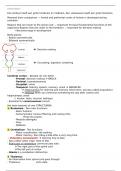Samenvatting
Samenvatting - Medicines Group: Drugs for the Central Nervous System - containing all lectures and all drugs (WBFA033-05)
- Instelling
- Rijksuniversiteit Groningen (RuG)
Summary of all the lectures of the course "Drugs for the CNS". All of the drugs and all of the mechanisms that you need to know for the exam are clearly stated and organized by subject. In this summary the lectures of: basic information on CNS structure and funtions, Alcohol and drugs, Huntington d...
[Meer zien]




